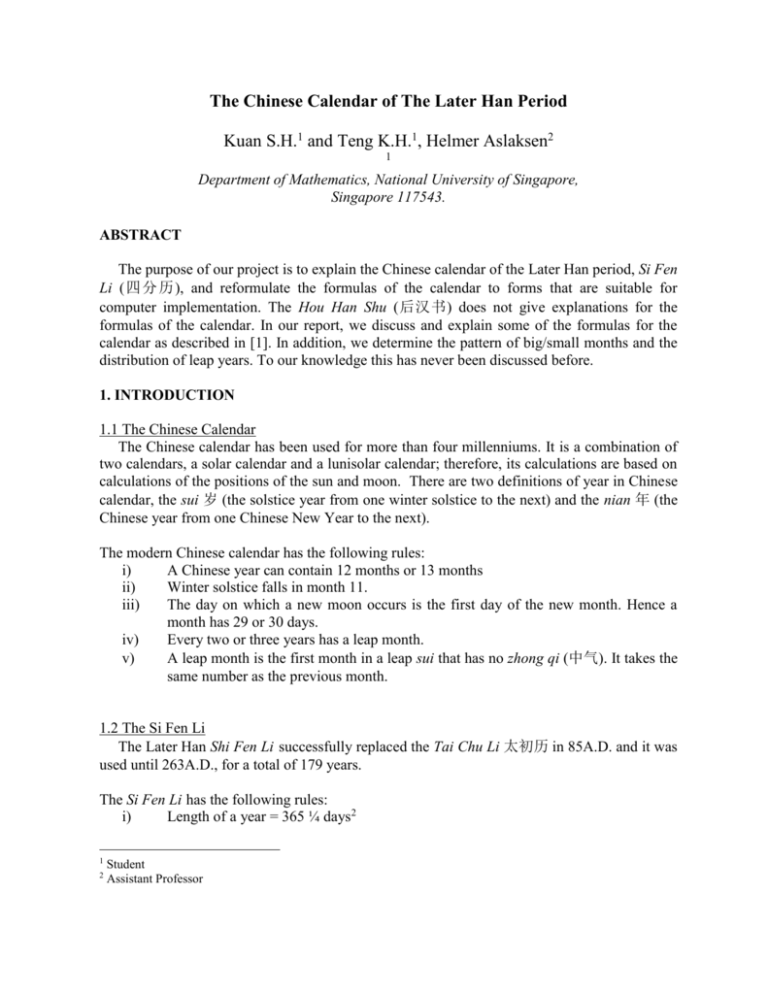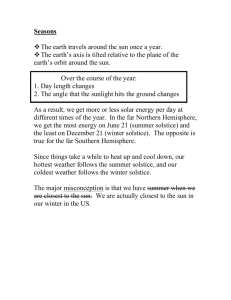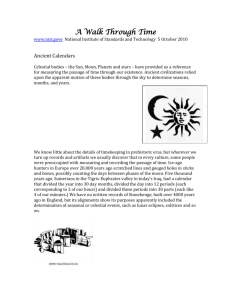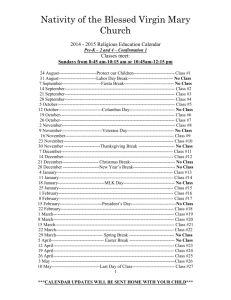The Chinese Calendar of The Later Han Period
advertisement

The Chinese Calendar of The Later Han Period Kuan S.H.1 and Teng K.H.1, Helmer Aslaksen2 1 Department of Mathematics, National University of Singapore, Singapore 117543. ABSTRACT The purpose of our project is to explain the Chinese calendar of the Later Han period, Si Fen Li (四分历), and reformulate the formulas of the calendar to forms that are suitable for computer implementation. The Hou Han Shu (后汉书) does not give explanations for the formulas of the calendar. In our report, we discuss and explain some of the formulas for the calendar as described in [1]. In addition, we determine the pattern of big/small months and the distribution of leap years. To our knowledge this has never been discussed before. 1. INTRODUCTION 1.1 The Chinese Calendar The Chinese calendar has been used for more than four millenniums. It is a combination of two calendars, a solar calendar and a lunisolar calendar; therefore, its calculations are based on calculations of the positions of the sun and moon. There are two definitions of year in Chinese calendar, the sui 岁 (the solstice year from one winter solstice to the next) and the nian 年 (the Chinese year from one Chinese New Year to the next). The modern Chinese calendar has the following rules: i) A Chinese year can contain 12 months or 13 months ii) Winter solstice falls in month 11. iii) The day on which a new moon occurs is the first day of the new month. Hence a month has 29 or 30 days. iv) Every two or three years has a leap month. v) A leap month is the first month in a leap sui that has no zhong qi (中气). It takes the same number as the previous month. 1.2 The Si Fen Li The Later Han Shi Fen Li successfully replaced the Tai Chu Li 太初历 in 85A.D. and it was used until 263A.D., for a total of 179 years. The Si Fen Li has the following rules: i) Length of a year = 365 ¼ days2 1 2 Student Assistant Professor ii) iii) iv) v) 7 leap months in 19 years (19 years with a total of 235 months). This calendar used mean values for the motion of the sun and the moon (ping qi 平 气 and ping shuo 平朔) to determine the lengths of jie qi 节气 and month. The year name for the initial year of the calendar (li yuan 历元) is geng chen (庚 辰). The ji nian 积年 for 1A.D. is 9282. Some important cycles of the Si Fen Li: i) One yuan is 4560 years. ii) One ji is 1520 years (one third of a yuan). iii) One bu is 76 years (one twentieth of a ji). iv) One zhang is 19 years (one forth of one bu). 2. EXPLANATIONS OF SOME FORMULAS The following formulas are some calculation methods of the calendar. We will give a brief explanation below for each formula. Q and R in those formulas are the quotient and remainder respectively. The computations are based on the astronomical year that starts with the new moon on or before winter solstice. (I) Calculation of ru bu 入部 (method to determine the position of a given year) Formula 1: Ji nian = 4560 x Q1 + R1 Q1 + 1 is the number of yuan (元) of the year since one yuan has 4560 years and we count yuan from 1 but Q1 starts at 0. Formula 2: R1 = 1520 x Q2 + R2 Q2 + 1 is the number of ji (纪) of the year since one ji has 1520 years and we count ji from 1 but Q2 starts at 0. Formula 3: R2 = 76xQ3 + R3 Q3 + 1 is the number of bu (部) of the year since one bu has 76 years and we count bu from 1 but Q3 starts at 0. R3 is the ru bu year of the current bu. The period for a ru bu year is from the winter solstice of the previous Chinese year (month 1 to month 12) to the winter solstice of the next Chinese year. (II) Calculation of tian zheng 天正 (method to determine whether the ru bu year is leap year) Formula 4: (R3 - 1) x 235 = 19 x Q4 + R4 235 is the number of months in a zhang, Q4 is the completed months from the beginning of the current bu until the winter solstice of the previous year (Chinese year, not ru bu year). R4 is the run yu of the year. (III) Calculation of the position of leap month (approximate position) Formula 5: (19 - R4) x 12 = 7 x Q5 + R5 If R5<4, then the (Q5 + 1)-th month of the ru bu year is a leap month. The leap month is the (Q5 + 2)-th month of the ru bu year if R5 4. By a simple calculation, we can see that the interval between a zhong qi and the new moon after it will be 3409/3760 days longer then the next such interval. After a few months, a month will not contain zhong qi and it is called leap month (this only happens in a leap ru bu year). Its number follows the number if the month before. (IV) Calculation of the length of a month Formula 6: Q4 x 27759 = 940 x Q6 + R6 If R6 441, then the month is a big month (30 days); otherwise, it is a small month (29 days). We know that the average length of a month in Si Fen Li is 29499/940 days. The first month of a bu has length 29499/940 days, which is less than 1, so the month is a small month. The next month has length 3058/940 days, so it is a big month. R6 is actually the numerator of the month before the winter solstice of the previous year, if it is more than 440, then the month on which the winter solstice falls in will has length more than 30 and hence it’s a big month. Formula 7: R6 + 499 = 940 x Q7 + R7 If R7 441, then the next month is a big month The explanation for this formula is similar to the previous formula. (V) Calculation of the 24 jie qi of the year (method to find the day name of each jie qi) Formula 8: (R3 - 1) x 168 = 32 x Q8 + R8 The total number of days before the winter solstice of the previous year is (365 ¼) x (R3 – 1). Because of the sixty cycle, we use (5 ¼) x (R3 – 1) (360 = 6 x 60) to determine the day name for the winter solstice. Q8 is the integral part of (5 ¼)x(R3 – 1). Formula 9: Q8 = 60 x Q9 + R9 R9 is the remainder of 60 divides (365 ¼) x (R3 – 1), so the number for day name of the winter solstice is R9 + the number for the first-day name of the current bu. Formula 10: R8 + 7 = 32 x Q10 + R10 The interval between two adjacent jie qi is 15 7/32, therefore its fraction is 7/32. The R8 in formula 8 is the numerator of the fraction for the winter solstice and the R10 is the numerator of the fraction for the next jie qi. Formula 11: R9 + 15 + Q10 = 60 x Q11 + R11 The day-name number of the next jie qi is the quotient of 60 divides 15 + Q10 + the number for day name of the winter solstice. 3. REFORMULATED METHODS AND ANALYSIS The formulas of the Si Fen Li stated in [1] are quite troublesome. By ignoring the 60-daays cycle of the Chinese calendar, we have reformulated some methods to determine date and time for full moon, length of a month and jie qi. We use term “Accumulated Days” to help our calculation. It is the total number of days since the beginning of the current bu cycle. It is a fractional number. Let AcD denote by “Accumulated Days” and n denote by greatest integral number smaller than n. (I) Calculation of date & time of full moon and length of a month AcD for the full moon of Y month in X ru bu year: AcD1 = ( (X – 1) 12 7 + ( Y 1 ) + ½ ) 29 499 940 19 AcD for the new moon of Y month in X ru bu year: AcD2 = ( (X – 1) 12 7 + ( Y 1 ) ) 29 499 940 19 Date of the full moon of Y month in X ru bu year = AcD1 AcD2 + 1 Time of the full moon of Y month in X ru bu year = ( AcD1 AcD1 ) 24 hours AcD for the new moon of ( Y + 1 ) month in X ru bu year: AcD3 = ( (X – 1) 12 7 + ( Y )) 29 499 940 19 Length of Y month in X ru bu year = AcD3 AcD2 (II) Calculation of date & time of Jie qi AcD for the Y zhong qi in X ru bu year: AcD4 = ((X 1) 12 + (Y 1)) 30 7 16 AcD for the new moon just before Y zhong qi in X ru bu year: AcD5 = AcD4 29 499 29 499 940 940 Date of the Y zhong qi in X ru bu year = AcD4 AcD5 + 1 Time of the Y zhong qi in X ru bu year = ( AcD4 AcD4 ) 24 hours The occurrence of the odd jie qi is in between two adjacent zhong qi. (III) Determination of leap month AcD for the new moon of Y month in X ru bu year: AcD6 = AcD1 AcD for the new moon of (Y + 1) month in X ru bu year: AcD7 = AcD2 If AcD6 = AcD7 and AcD6 AcD6 , Y month in X year is a leap month. REFERENCES Gao Ping Zi (高平子), Xue Li San Lun (学历散论), Institute if Mathematics, Academia Sinica, Taiwan, China. (1969) Helmer Aslaksen, The Mathematics of the Chinese Calendar, Department of Mathematics, National University of Singapore. (1999) URL:http://www.math.nus.edu.sg/aslaksen/calender/chinese Cui Zhen Hua (崔振华) and Chen Dong Sheng (陈东生), Zhong Guo Gu Dai Li Fa (中国古代 历法), Xin Hua Chu Ban She (新华出版社). (1993) Chen Jiu Jin (陈久金) and Yang Yi (扬怡), Zhong Guo Gu Dai De Tian Wen Yu Li Fa (中国古 代的天文与历法), Shang Wu Yin Shu Guan (商务印书馆), Taiwan. (1993) Tang Han Liang (唐汉良), Li Shu Bai Wen Bai Da (历书百问百答), Jiang Su Ke Xue Ji Shu Chu Ban She (江苏科学技术出版社). (1986)









